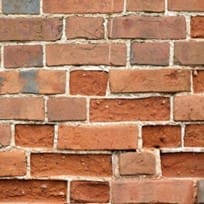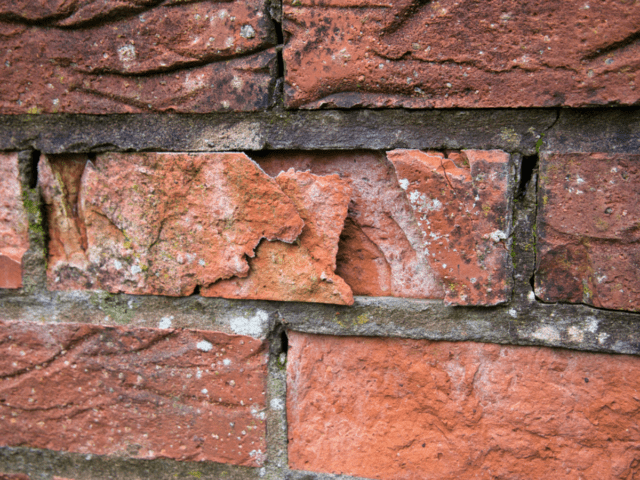Modern Mortar Can Destroy Antique Brickwork
When it comes to preserving brickwork of an antique home, selecting the right mortar can mean the difference between success and irreversible disaster. Most masonry professionals have a favorite off-the-shelf commercial mortar mix that they use for all of their repair and repointing work. What they may not realize is that modern mortar can spell disaster for bricks that are 100 years old or more. In this post, we explore why modern mortar is not suitable for repointing and repairing antique brickwork, and will provide recipes for mixing historically accurate custom mortar that can help save antique bricks from permanent damage.
What’s Wrong with Modern Mortar?
Nothing, really. Modern mortar, and modern bricks for that matter, are much more durable than their antique counterparts. The bricks and mortar sold today are much stronger and less permeable than the materials that were used in antique buildings. The key ingredient in modern mortar that gives it it’s strength is Portland cement, whereas historic mortars rely on much softer hydrated lime as the primary binding agent. While stronger mortar is a good thing in general, it actually creates problems for antique brickwork. When considering which mortar to use to repair or repoint bricks, the most important factor to consider is not strength or durability, but material compatibility. Antique bricks and mortar were made with softer, porous materials that hold more moisture and expand and contract more than modern bricks and mortar. When rock-hard modern mortar is paired with relatively soft antique bricks, it can lead to spalling, which can cause significant, irreversible damage over time.
What is Spalling?
Spalling occurs when the surface of the brick begins to flake or crumble away, exposing the inner material. Spalling is most often the result of expansion and contraction due to changes in temperature and moisture in combination with incompatible materials. These expansion and contraction cycles can be absorbed when the bricks and mortar have compatible softness and expansion rates, but when Portland cement-based mortar is used for repointing antique brick, the rigid mortar restricts this natural expansion, eventually causing the brick face to crack, crumble, and ultimately fall away.


Freeze-Thaw Cycles: The Northern Culprit
Spalling can happen in any climate, but it is exacerbated by the freeze-thaw cycles of the North. When water seeps into the brick and then freezes, it expands, putting pressure on the surrounding mortar. This is where the rigidity of modern mortar can be a detriment, as it does not allow for the natural movement of the bricks. The result? Increased spalling and faster degradation of the brickwork.
Compatible Mortar for Antique Brickwork
Despite how common antique brickwork is in the USA, and especially in the Northeast where my company is based, it is still not easy to find pre-mixed lime-based antique mortar mix at commercial brick suppliers, and that’s a big part of the problem. At the very least, its an indicator that many in the masonry industry aren’t aware of the problem and/or what to do about it. With some advance planning, masonry pros can order premixed historically-compatible mortars. One online source is Limeworks.us. They sell historic lime-based mortars in varying coarseness and colors to match your project requirements.
Another approach is to custom mix mortar with ingredients sourced from a pro masonry supply source in your area. The key is to mix a mortar that matches the flexibility and breathability of the original material.
Here are some guidelines for creating a compatible mortar:
Basic Lime Mortar Recipe
Ingredients:
- 1 part hydrated lime (available from pro masonry suppliers. Note: Garden center lime WILL NOT WORK!)
- 2 parts sand (preferably a mix of sharp and fine sand)
- Water (to achieve the right consistency)
Instructions:
- Mix Dry Ingredients: In a clean, dry mixer or mixing container, combine the hydrated lime and sand.
- Add Water Gradually: Slowly add water while mixing until you reach a smooth, workable consistency. The mix should be moist but not runny.
- Let It Rest: Allow the mortar to rest for about 30 minutes. This helps with workability and ensures proper hydration.
- Test the Consistency: The mortar should stick together when squeezed but not ooze water. If it is too dry, add a bit more water.
Tips for fine-tuning the recipe:
- For very old, soft brick (late 1800s or earlier, you can increase the sand to lime ratio to 3 parts sand (up to 6 parts sand) to 1 part hydrated lime
- For masonry dating to the early 1900s, you could make your mix a little harder and more durable by introducing a small amount of Portland cement and changing the lime & sand ratios as follows: 1 part cement to 3 parts lime to 12 parts sand. *If in doubt, just stick with the softer sand & lime mortar mix
Note: lime-based mortar has a shorter working time but takes longer to fully cure than cement-based mortar
Conclusion
Repointing antique brickwork is an art that requires specific knowledge and selecting the right materials. By avoiding modern mortars and instead purchasing or mixing your own lime-based mortar, you can preserve the integrity and beauty of your antique brickwork for years to come.
Working with trusted, local experts with extensive experience in antique renovations will pay off in multiple ways, including avoiding issues like this. North River Builders Inc. has decades of experience working in New England homes, and especially on antique properties, which has given us a depth of knowledge that makes a difference in how we approach each individual project. Please give us a call to discuss your next project, we are your local experts in home renovations! 978-341-0341.
Feel free to share your experiences or questions in the comments below. Happy restoring!

